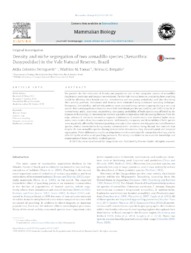Density and niche segregation of two armadillo species (Xenarthra: Dasypodidae) in the Vale Natural Reserve, Brazil.
Density and niche segregation of two armadillo species (Xenarthra: Dasypodidae) in the Vale Natural Reserve, Brazil.
Autoria: FERREGUETTI, A. C.; TOMAS, W. M.; BERGALLO, H. G.
Resumo: We provide the first estimates of density and population size of two sympatric species of armadillos (Euphractus sexcinctus and Dasypus novemcinctus) for the Vale Natural Reserve, evaluating how poaching would be affecting their habitat use (i.e. detectability and occupancy probability) and also describing their activity patterns. Abundance and density were estimated using a distance sampling technique. Occupancy, detectability, and activity patterns were assessed using camera-trapping during a one-year period. Estimated population densities were 0.06 individuals per hectare (ind/ha) and 0.05 ind/ha for D. novemcinctus and E. sexcinctus, espectively. Occupancy probability of both species was affected by the distance to forest edge. D. novemcinctus showed a positive relationship with increasing distance from the edge, whereas E. sexcinctus showed an opposite relationship. D. novemcinctus also showed higher occupancy rates in sites closer to a water resource. Additionally, occupancy and detectability of both species were negatively affected by historical poaching intensity in the reserve. Activity patterns varied between species, with D. novemcinctus being mostly nocturnal and E. sexcinctus being diurnal. We conclude that despite the two armadillo species sharing several niche dimensions, they showed spatial and temporal segregation. These differences may be an adaptation to reduce interspecific competition but may also be affected by the need to avoid poaching pressures. This study contributes to increase the knowledge and conservation of these two little-studied species.
Ano de publicação: 2016
Tipo de publicação: Artigo de periódico
Unidade: Embrapa Pantanal
Observações
1 - Por padrão são exibidas publicações dos últimos 20 anos. Para encontrar publicações mais antigas, configure o filtro ano de publicação, colocando o ano a partir do qual você deseja encontrar publicações. O filtro está na coluna da esquerda na busca acima.
2 - Para ler algumas publicações da Embrapa (apenas as que estão em formato ePub), é necessário ter, no celular ou computador, um desses softwares gratuitos. Sistemas Android: Google Play Livros; IOS: iBooks; Windows e Linux: software Calibre.
Acesse outras publicações
Acesse a Base de Dados da Pesquisa Agropecuária (BDPA) para consultar o acervo completo das bibliotecas da Embrapa.

